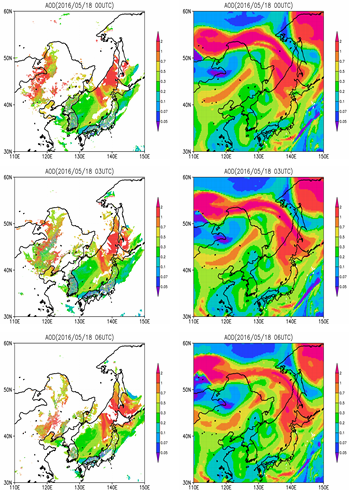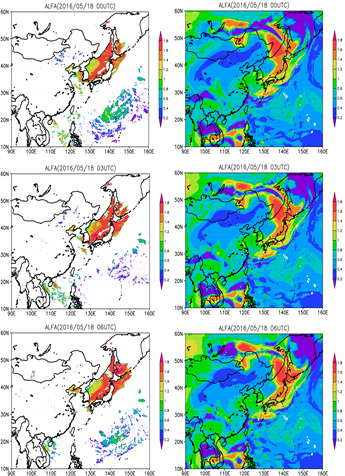Atmospheric Environmental Monitoring Simulation
JAXA Supercomputer System Annual Report April 2016-March 2017
Report Number: R16E0097
- Responsible Representative: Teruyuki Nakajima(Earth Observation Research Center)
- Contact Information: Maki Kikuchi(kikuchi.maki@jaxa.jp)
- Members: Kentaroh Suzuki, Daisuke Goto, Maki Kikuchi, Tomoki Fujiwara, Masamitsu Hayasaki
- Subject Category: Basic Research(Modeling)
Abstract
This project is aimed at development of an integrated system of numerical modeling and satellite observation of air pollution for its reliable monitoring and prediction. For this purpose, seamless atmospheric modeling system is operated on JSS2 to conduct simulations of air pollution transport over East Asia. The results are also validated against satellite observations of aerosols.
Goal
To develop an integrated system of numerical modeling and satellite observation of air pollution for its reliable, quasi real-time monitoring and prediction.
Objective
To conduct numerical simulations of air pollutions over Japan area with a next-generation, seamless modeling system of NICAM-SPRINTARS on JSS2 and to validate the simulations against satellite observations of aerosols. Through these researches, we intend to promote integration of numerical modeling and satellite observation for reliable monitoring and prediction of air pollutions.
References and Links
N/A
Use of the Supercomputer
We operate our high-resolution atmospheric modeling system of NICAM-SPRINTARS on JAXA supercomputer JSS2 to conduct numerical simulations of transport processes of air pollutions over East Asia.
Necessity of the Supercomputer
In the project, we need to conduct numerical simulations with high spatial resolutions over wide area including Japan and East Asia for reliable monitoring and predictions of air pollutions over the region. This requires us to exploit high performance super computing resources of JSS2 available at JAXA.
Achievements of the Year
In this fiscal year, we have successfully installed the NICAM-SPRINTARS modeling system into the JAXA’ssuper computer, JSS2. NICAM-SPRINTARS is a modeling system for meteorology and aerosol transport simulations that is applicable to regional- to global-scale simulations in a seamless manner where the domain sizes and spatial resolutions can be set flexibly according to the computational demand and available computational resources. Numerical simulations with the modeling system have been conducted on JSS2 to simulate aerosol distributions and transports over East Asia including Japan island. The simulation results have also been compared with satellite observations of aerosols obtained from Himawari-8 for evaluating and validating the model results. Shown in Fig. 1 is an example of such a comparison for the case of May 18, 2016 in the form of spatial distributions of aerosol optical depth (AOD), which is an index of aerosol turbidity. The simulation results (Fig. 1 right panels) demonstrate that the aerosols originating from forest fire over Siberia are transported over the continent to arrive at northern part of Japan island. This characteristic is also found in satellite observations (Fig. 1 left panels), suggesting that the model reasonably reproduces the aerosol distribution and transport in this particular case. This is also confirmed by Fig. 2 that shows Angstrom Exponent, which is an index of aerosol particle size. The simulations (Fig. 2 right panels) show that the aerosols arriving at northern part of Japan have large values of Angstrom Exponent, which means that the aerosols are dominated by small-sized particles. This characteristic can also be found in satellite observations (Fig. 2 left panels), suggesting that the model well represents the particle sizes of aerosols. These results alsosupport that the aerosols originate from the forest fire over Siberia in this particular case. The achievement of this fiscal year described above means that the NICAM-SPRINTARS modeling system has successfully started to operate on JSS2, which would enable us to conduct simulations for various cases in next fiscal year.

Fig.1:Comparisons of aerosol optical depth (AOD) between Himawari-8 satellite observations (left) and NICAM-SPRINTARS simulations (right) for the case in May 18, 2016 at 00UTC, 03UTC and 06UTC (top to bottom).

Fig.2:Comparisons of Angstrom Exponent between Himawari-8 satellite observations (left) and NICAM-SPRINTARS simulations (right) for the case in May 18, 2016 at 00UTC, 03UTC and 06UTC (top to bottom)
Publications
N/A
Computational Information
- Parallelization Methods: Process Parallelization
- Process Parallelization Methods: MPI
- Thread Parallelization Methods: n/a
- Number of Processes: 160
- Number of Threads per Process: 1
- Number of Nodes Used: 5
- Elapsed Time per Case (Hours): 8
- Number of Cases: 10
Resources Used
Total Amount of Virtual Cost(Yen): 213,757
Breakdown List by Resources
| System Name | Amount of Core Time(core x hours) | Virtual Cost(Yen) |
|---|---|---|
| SORA-MA | 81,398.09 | 133,445 |
| SORA-PP | 0.00 | 0 |
| SORA-LM | 0.00 | 0 |
| SORA-TPP | 0.00 | 0 |
| File System Name | Storage assigned(GiB) | Virtual Cost(Yen) |
|---|---|---|
| /home | 510.22 | 2,112 |
| /data | 10,099.42 | 41,812 |
| /ltmp | 8,789.07 | 36,387 |
| Archiving System Name | Storage used(TiB) | Virtual Cost(Yen) |
|---|---|---|
| J-SPACE | 0.00 | 0 |
Note: Virtual Cost=amount of cost, using the unit price list of JAXA Facility Utilization program(2016)
JAXA Supercomputer System Annual Report April 2016-March 2017


